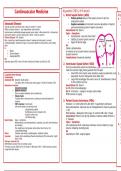Cardiovascular Medicine Acyanotic CHD (L R shunt)
1. Atrial Septal Defect (ASD) Acy
Ostium primum failure of the septum primum to join the 4. C
endocardial cushion N
Kawasaki Disease Septum secundum (commonest) excessive absorption of septum
Type of vasculitis commonly seen in boys, 6 months 5 years primum/incomplete growth of septum secundum
Affects coronary arteries + any large/medium sized arteries Associations FAD, Down’s
Autoimmune endothelial damage exposes tunica media More blood clots + Ischaemia
Signs + Symptoms
weak artery walls = coronary aneurysms (>8mm = likely to rupture)
Clinical features ‘RED’ disease Asymptomatic, recurrent chest infections
Red, cracked lips; raised temperature (doesn’t resolve with anti-pyretic), cervical Splitting S2 sound (systolic murmur)
lymphadenopathy, strawberry tongue, non-purulent bilateral conjunctivitis, rash all body Upper left sternal edge
parts Mx
Ix Cardiac catheterisation
Bloods w/ insertion of an occlusion device (secundum)
Echocardiogram Surgical (primum)
Angiography/MRI
Complications Paradoxical embolism
Mx
M
High-dose aspirin (KD is one of the few indications of Aspirin use (Reye’s), IVIG
2. Ventricular Septal Defect (VSD) S
From the endocardial cushion the membranous region grows downward to S
meet the muscular ridge growing upwards from the apex
Small VSD <3mm (aortic valve diameter) usually asymptomatic, loud 5. A
Congenital Heart Disease
Presentation pansystolic murmur (Holosystolic when SpO2 rise) R
Antenatal USS (between 18-20 weeks) Large VSD same/bigger than aortic valve, HF, breathlessness, failure M
Can detect 70% of infant who need surgery in the first 6 months of life to thrive Soft/no murmur A
Detection of murmur Associations FAD, Down’s
InnoSent murmurs Ix CXR, ECG, Echocardiography
Ejection murmurs
S
Mx HF Diuretics + captopril, increase calorie intake
Due to turbulent bloodflow at the outflow tract PHTN common surgery
Venous hums
Turbulent flow in the great veins, continuous noise head below the
clavicles 3. Patent Ductus Arteriosus (PDA) S
Still’s murmur (commonest) Persistent > 1 month after birth; after birth Ligamentum arteriosum
Left sternal border, low-pitched sound
C
During development, kept open due to Prostaglandins E2 (made by placenta
aSymptomatic patient M
+ DA)
Soft-blowing murmur (Grade 1-2/6) B
PGE2 declines + Bradykinin (from lungs) constricts SM in DA closes
Systolic murmur only
Associations Preterm, born @ high altitudes, maternal rubella infection in B
Left Sternal edge A
Heart failure Signs + Symptoms 1st trimester
Breathlessness (on feeding/exertion), sweating, recurrent chest infections, Signs + Symptoms
poor feeding Left, subclavicular thrill; continuous machinery murmur (Gibson’s), large 6. P
Poor weight gain, tachypnoea, tachycardia, heart murmur; S3, volume, collapsing, bounding pulse P
cardio/hepatomegaly Mx v
Shock Collapse, weak pulses, hepatomegaly, metabolic acidosis Indomethacin, PGE2, surgical ligation S
Cyanosis Causes: Cold, unwell/polycythaemia (peripheral); [Hb] reduced by >5g/dl M
SpO2 >94%
Nitrogen washout test
I
Differentiates cardiac from non-cardiac causes M
The infant is given 100% O2 for 10 minutes ABG taken: PO2 < 15kPa indicates cyanotic
congenital heart disease




